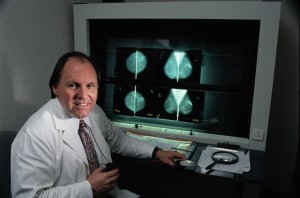 Mammography results are interpreted by radiologists – doctors who specialize in diagnosing diseases and injuries using medical imaging technology. The radiologist will look at each new mammogram and then compare it to previous mammograms, if available. This comparison helps pinpoint small benign changes or changes that could indicate the presence of breast cancer.
Mammography results are interpreted by radiologists – doctors who specialize in diagnosing diseases and injuries using medical imaging technology. The radiologist will look at each new mammogram and then compare it to previous mammograms, if available. This comparison helps pinpoint small benign changes or changes that could indicate the presence of breast cancer.
When looking at a mammogram, the radiologist looks for various types of changes, including:
• CALCIFICATIONS, which are essentially small mineral deposits within the breast tissue. Breast calcifications look like small white spots, and they may or may not be caused by cancer. They are classified as either macrocalcifications or microcalcifications. Macrocalcifications are larger, non-cancerous calcium deposits that are usually caused by aging of the breast arteries, old injuries or even inflammation. Microcalcifications are smaller and can sometimes indicate that breast cancer is present. Microcalcifications will often be biopsied in order to ensure an accurate diagnosis.
• MASSES, such as cysts or tumors. A cyst can be a benign fluid-filled sac, or it can be partially solid. The partially solid cysts are more likely to be associated with breast cancer, so these often needed to be biopsied. A tumor, also called a fibroadenoma, is a movable, solid, rounded lump made up of normal breast cells. Fibroadenomas are usually not cancerous, but they can grow. Cysts and tumors can feel the same on a physical exam, and even mammography has a difficult time distinguishing between the two. For this reason, a breast ultrasound is often done in order to help diagnose the mass.
• BREAST DENSITY, or the ratio of breast tissue to fatty tissue. Breast density is important in mammography because dense breasts can make it more difficult for radiologists to identify breast cancer. In addition, dense breasts are linked to higher risks of breast cancer.
Mammography is an important tool in diagnosing breast cancer in its earliest stages. Therefore, it is recommended that women have their prior mammograms available for the radiologist, particularly if they are changing doctors or medical imaging facilities. This will help ensure the most accurate interpretations.





